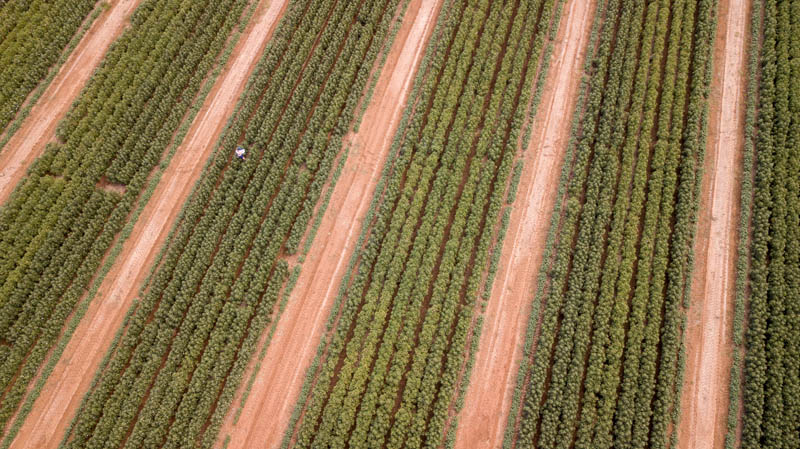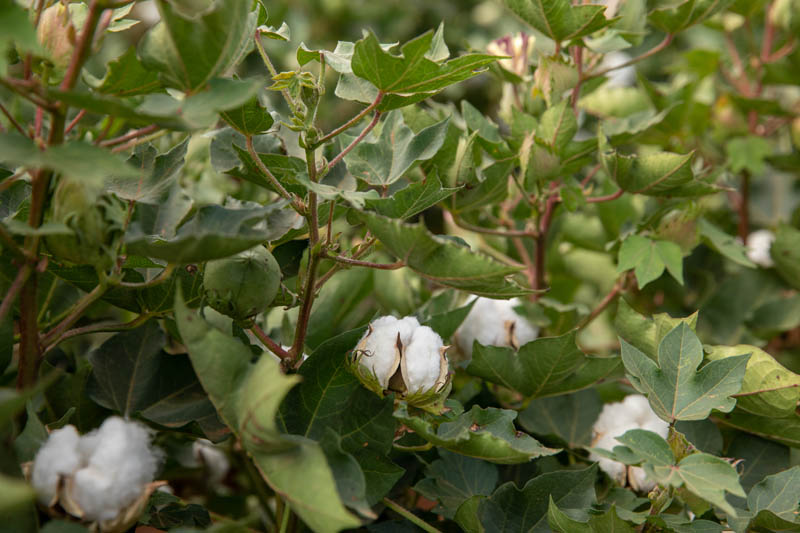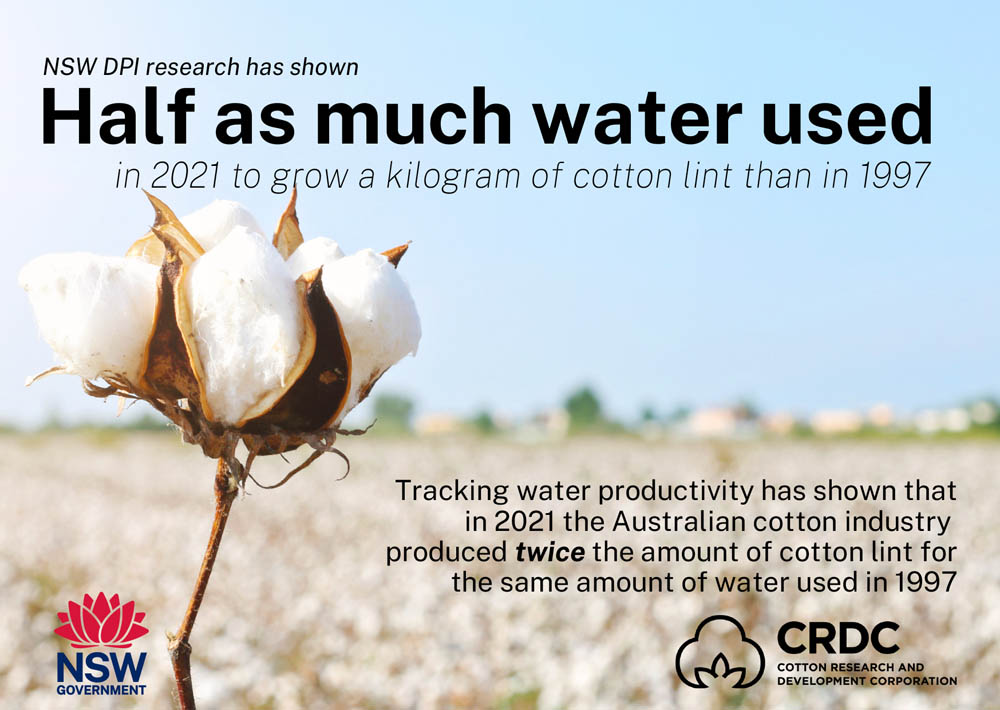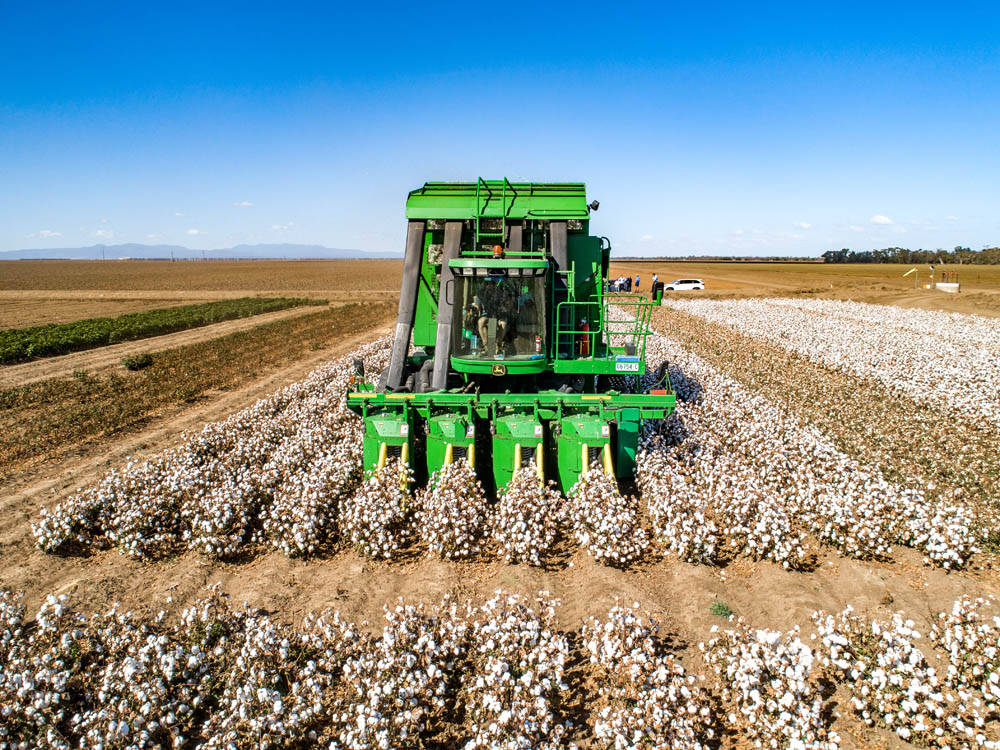Australian cotton exports were a standout in 2022-23 totalling $4.2 billion on exports of 1.28 million tonnes. This was almost double the $2.2 billion recorded in 2021-22 and 69% higher year-on-year in volume terms. 35 Global consumption of cotton is expected to lift in the year ahead with increased mill activity. Domestically, current water storages for NSW’s major river systems are supporting water availability for irrigators in 2023-24 and therefore the outlook for cotton production in the short term.
- GVP $2.3 billion est. Down 24% year-on-year - second highest on record.
- Production down 12% to 3.2 million bales.
- Strong demand underpinned $4.2 billion in national cotton exports.


Production
Cotton crops were challenged by wet conditions that delayed sowing and combined with milder growing temperatures, resulted in delayed harvesting for many NSW growers.
Cotton production and yield 1
- NSW Production
- Rest of Australia Production
- NSW Yield (RHS)
- Rest of Australia Yield (RHS)
Regional production estimates 147 148 h
- 2021-22 Area
- 2022-23 Area
- 2021-22 Production (RHS)
- 2022-23 Production (RHS)
Price
Variable production from major producers during 2022 contributed to the price volatility with drought impacting United States crops. The United States experienced 19% lower production and 11% drop in export volumes in 2022-23 over the prior year, with the United States the largest cotton exporter. 153 Other factors contributing to the price volatility included earlier mill purchases following on from COVID pandemic re-opening of supply chains and subsequent inventory destocking by mills over 2022-23. 153 154
Australian and international benchmark cotton prices 150 152
- Cotlook A Index
- Cash Price
Cotton and synthetic textile price indexes 150 156 157 ai
- Spun cotton yarn
- Spun synthetic yarn
- Cotton A Index (RHS)
Competition between synthetic yarn and natural fibres including cotton effectively places a ceiling on international cotton prices longer term. 155
Trade and Macroeconomic Conditions
Exports to Australia’s largest destination Vietnam represented 40% of export share by value and volume in 2023, with the value of exports more than doubling to $1.96 billion and 68% higher volume terms. Pakistan, Australia’s fourth largest cotton importer, saw Australian exports reach 90 thousand tonnes in 2022-23 which was up from 26 thousand tonnes the prior year. 35 This increase was partly attributed to Pakistan’s 35% reduction in domestic cotton production due to flooding in key growing provinces in 2022. 158
In contrast, exports to Indonesia were 9% lower year-on-year in volume terms, at 138 thousand tonnes. 35 The second largest market for Australian cotton in both total value and volume over the last two years, Indonesia has experienced a significant shift in total cotton consumption. Consumption decreased to a 30-year low in 2022-23, with total Indonesian imports of 348 thousand tonnes, 38% lower year-on-year. 153 Domestic cotton consumption in Indonesia has been impacted by reduced tourism following the COVID epidemic, at the same time domestic consumers have tended to substitute cotton with lower priced domestically produced synthetic apparel. Additionally, about 40% of Indonesian consumption is utilised in yarn manufacturing for export, especially to China. Indonesian cotton yarn exports were less than half the 5-year average between March 2022 to April 2023. 159
Australian Cotton Exports by Value 35
- Vietnam
- Indonesia
- India
- Bangladesh
- Pakistan
- Thailand
- RoW
Global cotton production, use and ending stocks 160
- Production
- Mill use
- Ending stocks
- Stocks to Use Ratio (RHS)
Outlook
Exports of Australia’s high-quality cotton will also potentially benefit in the longer term from the recently signed Australia-India Economic Cooperation and Trade Agreement, which includes Australian access to a 300,000-bale duty-free quota from 2023. 164 For context, Australian cotton exports to India totalled 111 thousand tonnes which is equivalent to 489,000 bales in 2022-23.
The initial outlook water storages for NSW’s major river valleys and systems appear supportive for cotton production in 2023-24. Most irrigation schemes are at or near full capacity, supporting current generally higher General Security water allocations. 161 However seasonal conditions such as the development of an El Niño in 2023-24 163 are expected to influence the ultimate allocation of General Security water for cotton irrigators, while drying soil profiles reported in the north west of NSW may limit opportunities for dryland sowing of cotton in the region. 59
Stronger Primary Industries Strategy
Benchmarking water productivity of Australian irrigated cotton
Strategic Outcome

- 6.1 Assess and monitor natural resource health for sustainability

NSW DPI Agriculture research has shown half as much water was used in 2021 to grow a kilogram of cotton lint than in 1997. The amount of water used in 1997 actually produces double the amount of cotton. Water productivity measures the weight of cotton lint produced per unit of water used to grow it. Improved water productivity and water sustainability are driven by increased yield and reduced water consumption, during a period when rainfall is declining.
This NSW DPI research is rooted to the experience of growers on the ground. Grower records of water were used to estimate the water balance for each farm, capturing all water inputs and outputs. This data was used to calculate water productivity and water sustainability indices, and irrigation efficiency metrics, as well as to identify where and how much irrigation water is lost, in the irrigated farming system.



